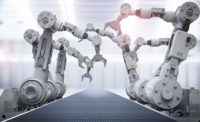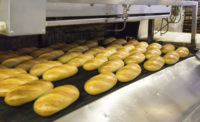Research: Cobot market to exceed $11B by 2030
The study finds that the yearly revenue for cobot arms will reach $11.8 billion by 2030, an increase from $711 million in 2019.

The collaborative robotics (cobot) market will become increasingly mainstream over the next 10 years, according to “Industrial Collaborative Robots Market Tracker,” new analysis from ABI Research, New York. The study finds that the yearly revenue for cobot arms will reach $11.8 billion by 2030, an increase from $711 million in 2019. More than that, the total value of the collaborative market is considerably more, when accounting for software-related revenues and end-of-arm tooling (EOAT) accessories. Under this broader definition of the market, the cobot ecosystem is worth just over $1 billion in 2019, and will be worth $24 billion by 2030, with a CAGR of 28.6%.
“The prospects for the collaborative robotics market remain strong, despite some very visible inhibitors,” says Rian Whitton, senior analyst. “The hardware innovation is still trailing behind, and most of the value related to cobots does not come from collaboration. It comes through ease-of-use, re-programmability, lower total cost compared to industrial systems and re-deployability. In essence, the value is one of lowering barriers rather than building entirely new use-cases for robots. What is more, cobots still trail industrial systems in speed, performance and payload, which will have to change if adoption is to continue at this feverish rate.”
Currently, the cobot market as a percentage of the industrial market is very small. In terms of revenue, all revenue from cobot arms is 5% of industrial robot hardware, but that will increase to 29% by 2030. This growth is not just related to adoption, but also to the increasing convergence between the two sub-groups. Through advances in sensors, machine vision and motion control, industrial robots will increasingly take on the benefits of collaborative systems. The value prospect for software innovation is strong too, growing from $558 million in 2020 to $10.6 billion in 2030. Most of this value will be attributed to analytics, perception, motion control and operations-related software.
“Collaborative systems are not revolutionizing the industry so much as being the catalyst for a leaner and more flexible industrial robotic solution that opens the field up to small and medium manufacturers. As the demands of customization and high-mix, low-volume manufacturing present managers with new challenges, this technological development will be crucial in transitioning to a more adaptable solution,” Whitton adds.
Looking for a reprint of this article?
From high-res PDFs to custom plaques, order your copy today!








